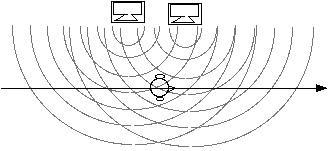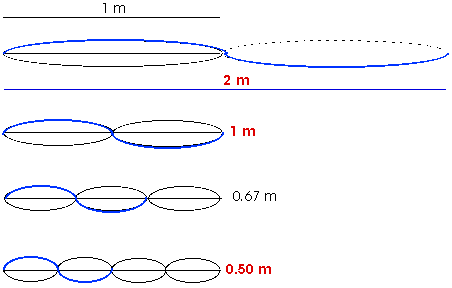If The Frequency Of Sound Is Doubled, How Will Its Speed Change? How Will Its Wavelength Change?

Excursions in Physics
Homework, Chapter 11: Waves
(this is Affiliate 11 of Adventures in Physics , available only online)
Ch eleven, Waves; i, 3, 7, viii, 9, 12, xiv, 15
![]()
1. If the frequency of a wave is increased, what happens to its wavelength?
Equally the frequency increases, the wavelength decreases.
2. If the frequency of a moving ridge is doubled, what happens to its wavelength?
If the frequency is doubled, the wavelength is but half as long.
3. If you put your fingertip in a pool of water and repeatedly move it up and down, yous will create round water waves that move out from that point. What will happen to the wavelength of these waves if y'all movement your finger up and down more slowly (or less frequently)?
As the frequency slows down, the wavelength increases.
iv. As a wave goes by, how far does it motility during one period?
During each menses, the moving ridge moves one wavelength.
v. If the amplitude of a moving ridge is increased 10%, what happens to the wave speed?
The wavespeed does non alter with the period.
vi. Can a transverse wave travel forth a Slinky toy?
A Slinky toy can support both a transverse wave and a longitudinal wave.
7. Tin a sound wave be polarized?
Sound is a longitudinal moving ridge so it can non exist polarized.
8. Can a low-cal moving ridge be polarized?
Lite is a transverse wave and then information technology tin can be polarized.
9. If exactly the same indicate is sent to two speakers, what volition a listener hear every bit she walks along a line parallel to the speakers (as illustrated in the sketch)?

The sound waves from the 2 speakers volition add together together by superposition. At some points, the two sound waves will exist pushing the air molecules in the same direction and we will hear a big aamplitude; this is called constructive interference or a sound maximum. At other points, the ii audio waves will be pushing the air molecules in the opposite direction and we will hear a small amplitude; this is chosen destructive interference or a sound minimum.
12. Why does the amplitude of a water wave decrease as the moving ridge spreads out from its source?
The energy -- or ability -- in the wave is spread out over a greater surface area and then the aamplitude is smaller.
xiv. Advisedly hold a metal rod horizontally at its mid-point. If you and so strike it horizontally on its terminate, what kind of wave will be created in the rod? If you then strike information technology vertically on its finish, what kind of moving ridge will be created in the rod? Will the sound you lot hear be the aforementioned or different for these two cases? Why?
Striking information technology horizontally on its terminate should cause a longitudinal moving ridge through the rod. Striking it vertically on its end should cause a transverse wave along the rod. The 2 waves are quite different so their wave velocities will be quite different and, therefore, their resonant frequencies will be quite unlike. That is, the sound produced will exist quite different.
fifteen. Describe some mutual examples of resonance.
Perhaps the start example of resonance that comes to mind is the resonance of a pendulum every bit seen in a common playground swing. The resonance of a pendulum in a clock is another ready example. Resonance is as well used in tuning a radio or television receiver. Resonance of air molecules is involved in the blue colour of the heaven. Resonance is used in every musical instrument.
Typical Multiple Choice Questions:
1. Like a transverse wave, a longitudinal wave has a/an
A) aamplitudeB) frequency
C) wavelength
D) all of the above
ii. Which of the following is a longitudinal wave?
A) low-calB) moving ridge on a string
C) sound
D) all of the in a higher place
3. The private vibrations or disturbances of a transverse wave movement
A) in the aforementioned direction as the moving ridge itselfB) perpendicular to the moving ridge itself
iv. A wave has a frequency of 100 Hz and travels 25 yard in 1 second. It has
A) a moving ridge speed of 25 yard/s and a wavelength of 4 m.B) a wave speed of 25 m/s and a wavelength of 0.25 m.
C) a moving ridge speed of 100 thou/s and a wavelength of 25 m
D) a wave speed of 100 chiliad and a wavelength of iv k
five. For standing waves, nodes are
A) always a wavelength apartB) regions of greatest aamplitude
C) regions of greatest frequency
D) ever two wavelengths apart
half-dozen. For standing waves, antinodes
A) are half a wavelength autonomouslyB) have the greatest amplitude
C) alternate with nodes
D) all of the above
7. For standing waves on a cord,
A) a node is located at each ceaseB) a whole number times half the wavelength equals the length of the cord
C) the whole "pattern" of continuing waves occurs only for sure frequencies
D) all of the above
8. For standing waves on a string,
A) an antinode is located at each endB) the length of the string equals the wavelength divided by a whole number
C) the amplitude is proportional to the frequency
D) all of the in a higher place
E) none of the higher up
9. On a string that is 1.0 k long, continuing waves may be formed with the following wavelengths:
A) ane.0 grand, 2.0 one thousand, three.0 mB) one.0 m, 2.0 m, 4.0 m
C) 3.0 k, 1.5 m, 0.75 m
D) two.0 m, 1.0 m, 0.v m

20. Standing waves can occur when
A) the frequency equals the wavelengthB) the amplitude exceeds the wavelength
C) a wave is reflected back on itself
D) a wave'south flow equals its wavelength
xi. A node is
A) always in the heart of a standing waveB) a position of maximum aamplitude
C) a position of minimum amplitude
D) equal to the fundamental frequency
12. A bobber on a fishing line oscillates upward and down three times per 2nd as waves pass by. The waves accept a frequency of
A) (one/3) HzB) three Hz
C) (ane/3) sec
D) 3 sec
13. A bobber on a line-fishing line oscillates upward and downwards two times per 2d as waves pass by. The waves have a wavelength of 10 cm. The waves are traveling at
A) five cm/due southB) 10 cm/s
C) xx cm/due south
D) 980 cm/s
14. If you put your fingertip in a pool of water and repeatedly movement it up and down, you will create circular water waves that motility out from that signal. What will happen to the wavelength of these waves if you motion your finger up and downwards more slowly (or less frequently)?
A) increaseB) remain the same
C) decrease
Answers to these Typical Multiple Choice Questions:
1. Similar a transverse wave, a longitudinal wave has a/an
A) amplitudeB) frequency
C) wavelength
D) all of the above
2. Which of the following is a longitudinal wave?
A) calorie-freeB) wave on a string
C) audio
D) all of the to a higher place
3. The individual vibrations or disturbances of a transverse moving ridge motion
A) in the aforementioned management as the wave itselfB) perpendicular to the wave itself
4. A moving ridge has a frequency of 100 Hz and travels 25 thou in i second. It has
A) a wave speed of 25 m/south and a wavelength of 4 m.B) a wave speed of 25 g/southward and a wavelength of 0.25 thou .
five = (wavelength) ten (frequency)v = 25 m/southward = (wavelength) x (100 Hz)
25 m/south = (wavelength) x (100 1/s)
wavelength = 0.25 one thousand
C) a wave speed of 100 grand/s and a wavelength of 25 1000
D) a wave speed of 100 chiliad and a wavelength of four m
5. For standing waves, nodes are
A) always a wavelength apart ; nodes are half a wavelength autonomouslyB) regions of greatest aamplitude ; nodes have minimum (zero!) amplitude
C) regions of greatest frequency ; all parts of a continuing wave have the same frequency
D) ever two wavelengths autonomously ; nodes are half a wavelength apart
Eastward) none of the higher up
6. For standing waves, antinodes
A) are half a wavelength apartB) have the greatest amplitude
C) alternate with nodes
D) all of the to a higher place
7. For standing waves on a string,
A) a node is located at each endB) a whole number times half the wavelength equals the length of the string
C) the whole "pattern" of standing waves occurs simply for certain frequencies
D) all of the in a higher place
8. For standing waves on a string,
A) an antinode is located at each endB) the length of the string equals the wavelength divided by a whole number
C) the amplitude is proportional to the frequency
D) all of the above
E) none of the above
9. On a cord that is ane.0 m long, standing waves may be formed with the following wavelengths:
A) 1.0 m, 2.0 m, iii.0 thouB) 1.0 grand, 2.0 m, 4.0 m
C) iii.0 m, 1.5 m, 0.75 m
D) ii.0 thousand, i.0 m, 0.5 m

10. Continuing waves can occur when
A) the frequency equals the wavelengthB) the amplitude exceeds the wavelength
C) a moving ridge is reflected back on itself
D) a wave's catamenia equals its wavelength
xi. A node is
A) ever in the middle of a standing waveB) a position of maximum amplitude
C) a position of minimum amplitude
D) equal to the fundamental frequency
12. A bobber on a fishing line oscillates upwardly and down three times per second every bit waves pass past. The waves have a frequency of
A) (1/3) HzB) 3 Hz
C) (1/iii) sec
D) 3 sec
thirteen. A bobber on a fishing line oscillates up and down two times per second every bit waves pass by. The waves have a wavelength of 10 cm. The waves are traveling at
A) 5 cm/sB) ten cm/s
C) xx cm/s
f = two Hz = ii cyc/due southv = (wavelength) 10 (frequency)
v = (ten cm) x ( 2 / due south)
v = 20 cm/s
D) 980 cm/due south
14. If you put your fingertip in a puddle of water and repeatedly move it up and down, you volition create round h2o waves that move out from that bespeak. What volition happen to the wavelength of these waves if y'all move your finger up and down more slowly (or less oft)?
A) increase5 = (wavelength) x (frequency)A decrease in frequency means an increase in wavelength.
B) remain the same
C) decrease
| Dorsum to 3050's Domicile Page | Dorsum to Calendar | ToC, Ch 11 | Ch 12, Sound and Music |
![]()
(C) 2003, Doug Davis; all rights reserved
Source: https://ux1.eiu.edu/~cfadd/3050/Hmwk/Ch11.html
Posted by: laforestoulds1946.blogspot.com


0 Response to "If The Frequency Of Sound Is Doubled, How Will Its Speed Change? How Will Its Wavelength Change?"
Post a Comment